Aluminum Cable Market Size and Trends
Global aluminum cable market is estimated to be valued at USD 26.59 Bn in 2025 and is expected to reach USD 38.46 Bn by 2032, exhibiting a compound annual growth rate (CAGR) of 5.4% from 2025 to 2032.
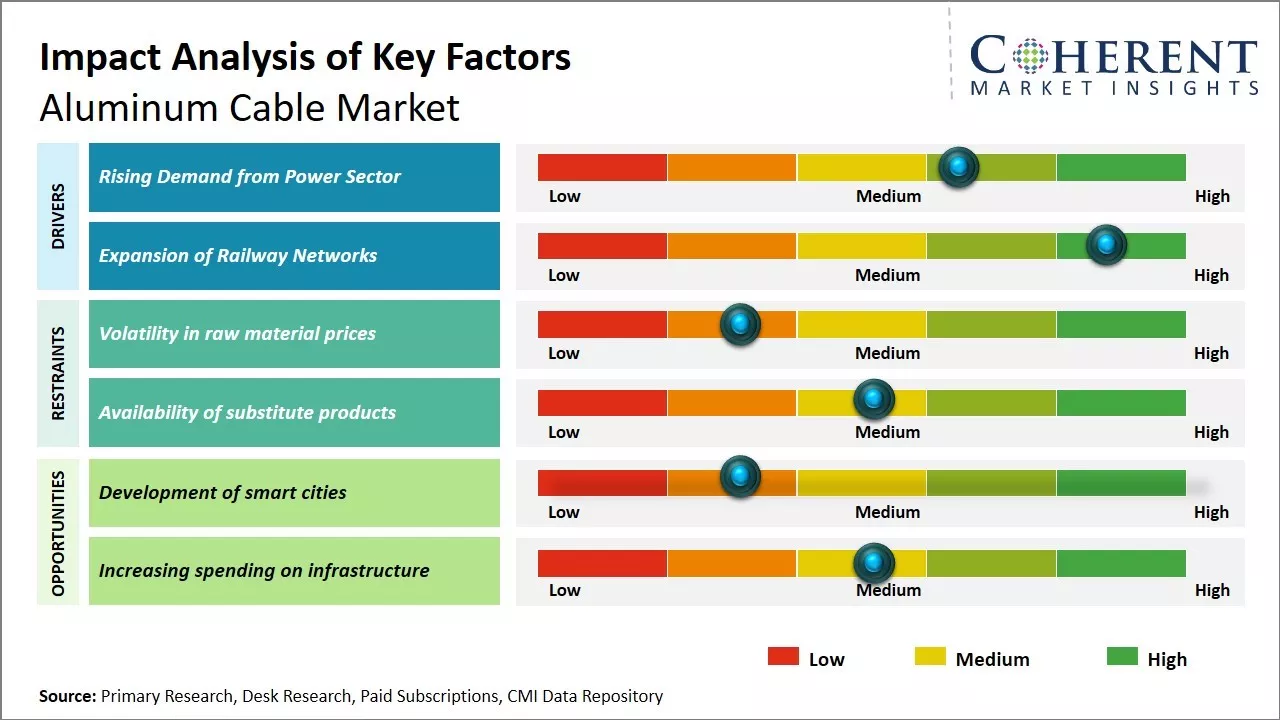
Discover market dynamics shaping the industry: Download Free Sample
Global aluminum cable market is expected to witness significant growth over the forecast period, owing to growing demand for electricity across the world due to rapid urbanization and industrialization. Aluminum cables are widely used due to their lightweight and high conductivity properties that reduces transportation costs. Moreover, aluminum cables do not corrode or rust over time like other metal cables and these are also easier and cheaper to install due to light weight. The development of new infrastructure projects especially in emerging nations along with renovation of existing infrastructure i can boost demand for aluminum cables. Supportive government policies and programs regarding power transmission and distribution can drive the market growth.
Rising Demand from Power Sector
The demand for aluminum cables from the power sector has been steadily rising in recent years and this growth in demand is expected to drive the global aluminum cable market upwards in the coming decade. Aluminum conductors have seen wider adoption in power transmission and distribution networks as they offer significant benefits over conventional copper conductors. Aluminum cables are much lighter compared to copper cables of similar conductivity specifications. This reduces transportation and material handling costs considerably for power utilities. With the length of power lines running into thousands of kilometers, this cost benefit of lighter aluminum cables becomes amplified. Besides being lighter, aluminum also has higher electrical conductivity per unit weight compared to copper. This allows for larger power carrying capacity using aluminum conductors of similar cross-sectional area. As a result, existing power lines can be upgraded or expanded in capacity using aluminum conductors without needing to put additional supporting infrastructure in place.
Market Concentration and Competitive Landscape
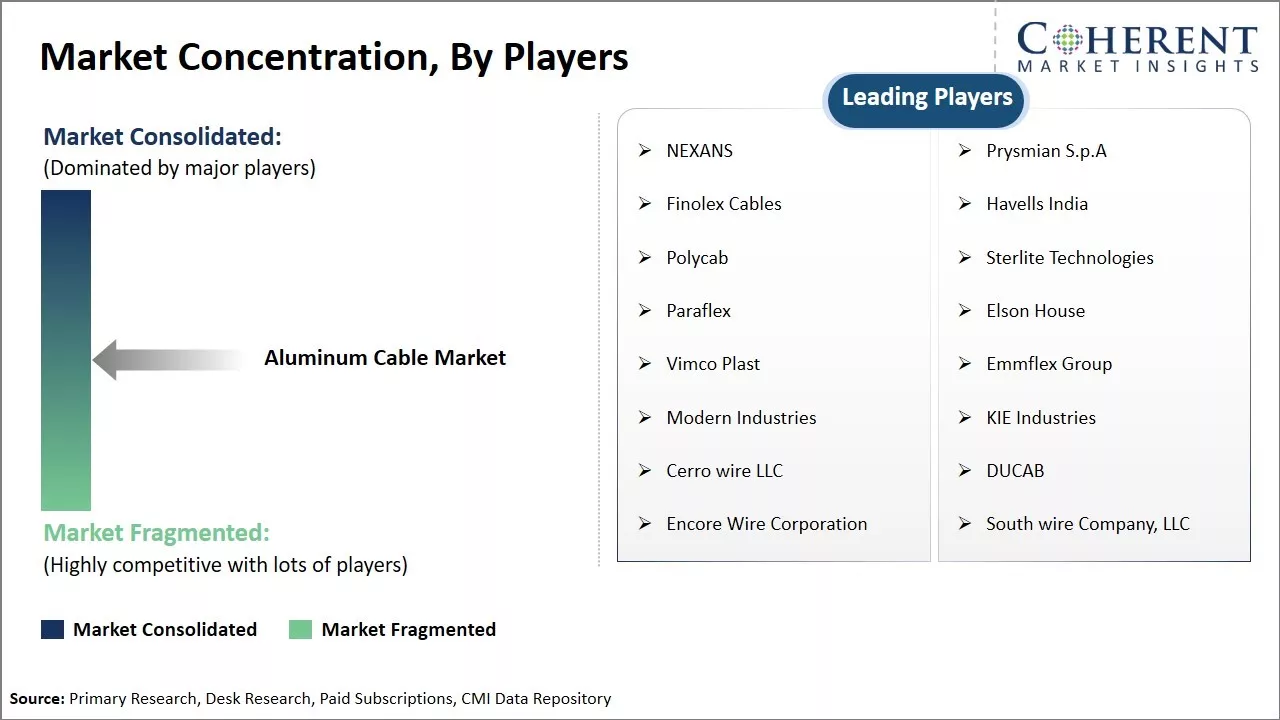
Get actionable strategies to beat competition: Download Free Sample
Expansion of Railway NetworksThe expanding railway networks across the globe has greatly contributed to the growth of the global aluminum cable market. As more countries invest in developing their rail infrastructure for both passenger and freight transportation, the demand for aluminum cables has significantly increased. Aluminum cables experience less electrical resistance as compared to conventional copper cables, making them suitable for high voltage applications. With longer railway tracks being laid that involve transmission of heavy currents over long distances, the low resistance property of aluminum cables becomes highly advantageous. Additionally, aluminum cables are lighter in weight than copper cables, allowing for ease of installation work in rail projects. Their light weight also means lower shipping costs of cables and less material required overall for railway electrification works. A key current trend spurring the aluminum cable market is the numerous multi-billion-dollar high-speed railway projects underway globally. For example, according to the National Development and Reform Commission of China, the country is expected to invest over USD 420 billion until 2025 on its national high-speed rail network which will cover over 38,000 km of track. Similarly, India has embarked on ambitious targets of expanding its railway network by developing new dedicated freight corridors, high-speed bullet trains and elevated metro rail systems in all major cities at a cost of over USD 150 billion as per the Ministry of Railways, Government of India. These massive investments in modernizing rail infrastructure demand sophisticated equipment including large volumes of aluminum cables to empower signal systems, overhead electrification works and other applications.
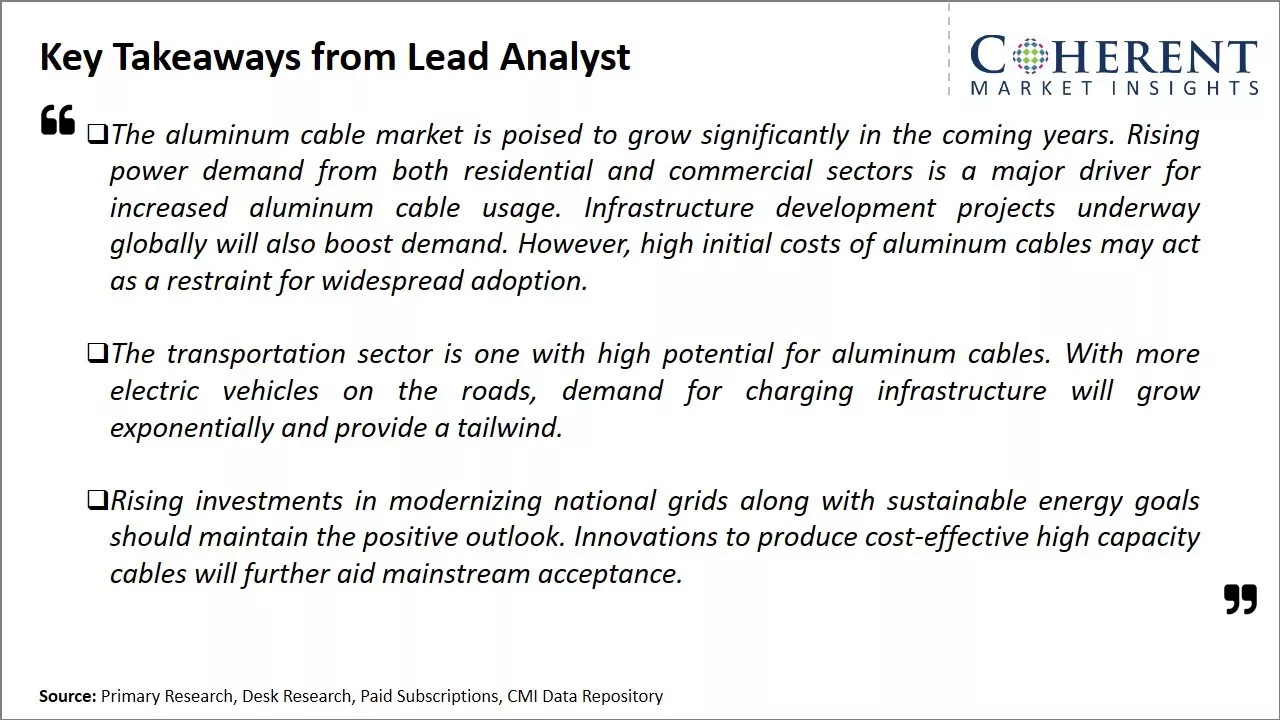
To learn more about this report, Download Free Sample
Market Challenge: Volatility in raw material pricesVolatility in raw material prices can hamper the global aluminum cable market growth. Aluminum is one of the key raw materials used in the production of aluminum cables, however, aluminum prices have been quite volatile in the recent years. Aluminum is sourced from bauxite mines and the price of bauxite is dependent on international commodities markets. Thus, any fluctuations in the price of bauxite is directly reflected in aluminum prices. In 2020-2021, prices of aluminum witnessed fluctuation ranging between 15-30% due to uncertain economic environment caused due to COVID-19 pandemic. The fluctuating prices made effective forecasting and planning quite challenging for aluminum cable manufacturers. The volatility had significant ramifications on the operations and profitability of aluminum cable manufacturers. With raw material costs constituting over 60% of the total production costs, unstable aluminum prices meant frequent changes had to be made to product pricing, and this renders marketing and sales strategies ineffective in the short term. Manufacturers were forced to decide between absorbing higher costs and losing margins or regularly increasing product prices to pass on the rising costs. Both options impacted consumer demand and purchasing decisions in the short run.
Market Opportunity: Development of smart cities
The rapid urbanization across the world is driving many governments to focus on developing smart and sustainable cities. These smart cities aim to improve quality of life for citizens by leveraging the latest technologies to boost efficiency and connectivity. One of the major focus areas for smart cities is building out underground and overhead infrastructure for power transmission and telecommunications networks. As more smart cities projects take shape, there will be a massive demand for laying down cables to enable the high-speed data transmission and smart grid capabilities envisioned by these developments. Aluminum is increasingly becoming the material of choice for power and telecom cables due to its lightweight and corrosion resistant properties. Aluminum cables allow for longer transmission distances without additional voltage drops as compared to copper. Thse also have significantly less oxygen permeability, thus, reducing maintenance and repair requirements over the cable lifespan.
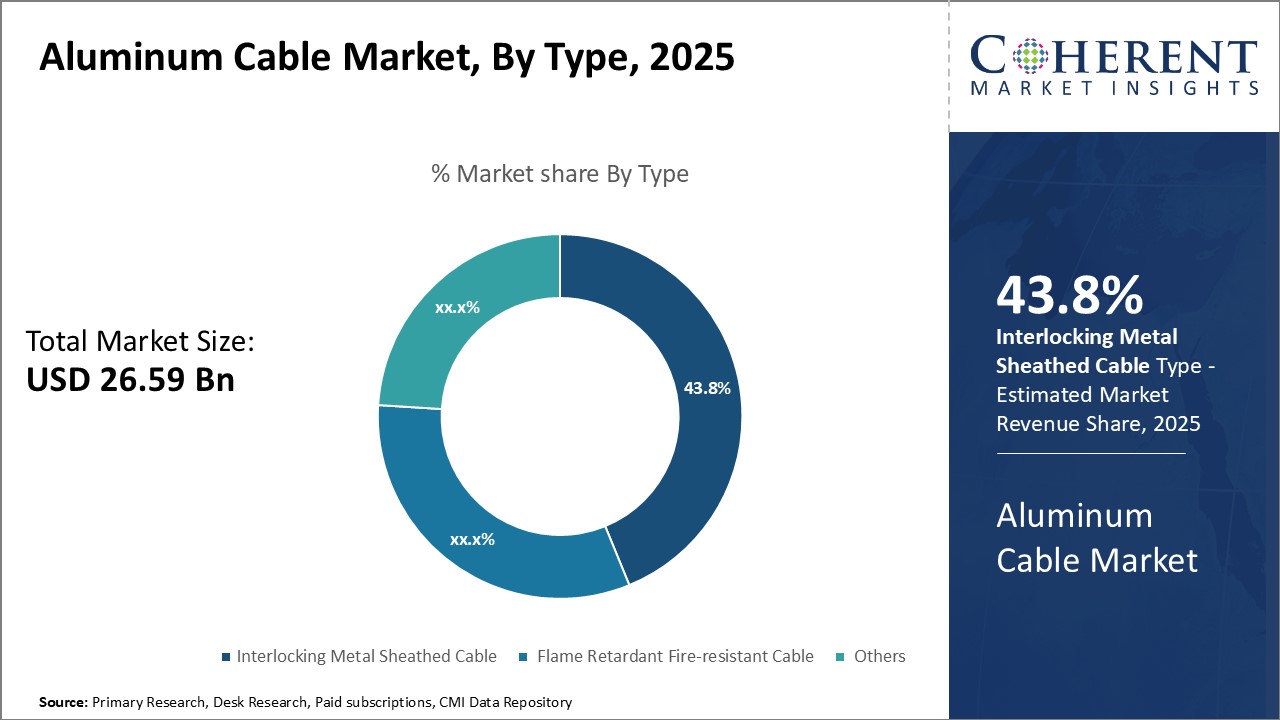
Discover high revenue pocket segments and roadmap to it: Download Free Sample
Insights, By Type: Durability and safety of interlocking metal sheathed cable boosts its demandIn terms of type, interlocking metal sheathed cable segment is estimated to contribute the 43.8% of the market share in 2025. Interlocking metal sheathed cable is commonly used in aluminum cable market due to its excellent mechanical protection and moisture resistance properties. The interlocked corrugated steel tape provides 360-degree coverage around the cable core, forming a continuous protective barrier against cuts, abrasions and environmental stresses. Its flexible yet robust steel armor layer ensures safe handling and installation of the cable even in rough outdoor conditions. The overlapping metal sheath eliminates any gaps or openings that can let moisture seep in, thus, protecting the conductor from corrosion and degradation over long term use. The self-closing interlocked construction of metal sheath practically eliminates any ingress of water even after cable cuts or damage to outer sheath. This makes it a preferred choice for underground wiring applications where exposure to moisture is high. It is also favorably used in areas prone to rodent bites or termite attacks due to its strong mechanical shielding around the conductor.
Insights, By Application: Rising demand for consumer electronics can drive electrical appliances segment growth
In terms of application, electrical appliances segment is estimated to contribute the 33.2% of the market share in 2025 due to rapid growth of the consumer electronics and home appliances industry globally. Increased purchasing power, changing lifestyles and rising disposable incomes have boosted the sales of various consumer goods like air conditioners, refrigerators, washing machines, televisions, laptops and other small appliances. As these appliances require flexible, durable and affordable power cables for indoor wiring setup, aluminum cables have emerged as the preferred choice compared to other materials. Aluminum cables score high on conductivity for delivering power while being significantly lighter in weight compared to copper variants. This makes transportation and installation easier. Aluminum materials contribute to cost savings which get passed on to consumers in the form of affordable price points. The steady upgrading of home and kitchen appliances to larger sizes and new technologies will further propel the consumption of aluminum cables for reliable indoor wiring applications. On the whole, expanding markets for consumer electronics and home appliances are a major driver for higher aluminum cable demand in the electrical appliances segment.
Regional Insights
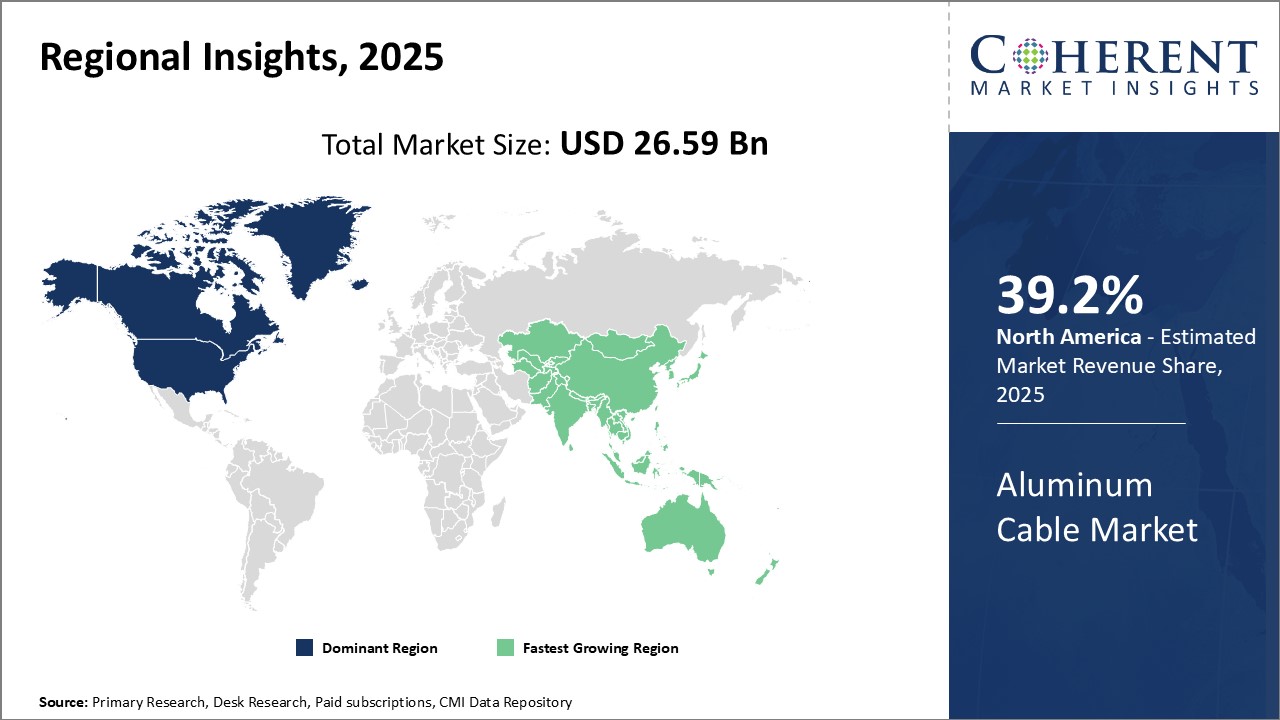
Need a Different Region or Segment? Download Free Sample
North America has established itself as the dominant region in the global aluminum cable market over the past decade with estimated 39.2% share in 2025. With countries like the U.S. and Canada having well-developed industrial and commercial infrastructure, there has been huge demand for aluminum cables. The power and utility sector has boosted usage of aluminum cables for transmission and distribution networks. Moreover, presence of aluminum cable manufacturers such as Southwire Company and Prysmian Group has further augmented the supply chain and boosted regional market size. These firms have established robust supply networks and offer a wide product range at competitive prices. Strong government focus on power infrastructure upgrades under investment plans like the US infrastructure bill can also drive the market growth.
The Asia Pacific region has emerged as the fastest growing market for aluminum cables globally. Rapid urbanization and industrialization across developing economies like China and India has boosted demand from construction as well as energy sectors. China, being the world's second largest economy, accounts for over 35.5% of the Asia Pacific market. It holds a leading position in aluminum production, power generation as well as manufacturing of aluminum cables. Growing infrastructure investments towards mega projects such as high-speed railroads and smart cities programs boosts usage of aluminum cables. Countries in Southeast Asia such as Vietnam, Indonesia and the Philippines are also representing high growth opportunities. Their increasing exports along with expanding manufacturing industries has boosted regional cable requirements.
Market Report Scope
Aluminum Cable Market Report Coverage
| Report Coverage | Details | ||
|---|---|---|---|
| Base Year: | 2024 | Market Size in 2025: | USD 26.59 Bn |
| Historical Data for: | 2020 To 2024 | Forecast Period: | 2025 To 2032 |
| Forecast Period 2025 to 2032 CAGR: | 5.4% | 2032 Value Projection: | USD 38.46 Bn |
| Geographies covered: |
|
||
| Segments covered: |
|
||
| Companies covered: |
NEXANS , Prysmian S.p.A, Finolex Cables, Havells India, Polycab , Sterlite Technologies, Paraflex , Elson House, Vimco Plast, Emmflex Group , Modern Industries, KIE Industries, Cerro wire LLC, DUCAB, Encore Wire Corporation, South wire Company, LLC |
||
| Growth Drivers: |
|
||
| Restraints & Challenges: |
|
||
Uncover macros and micros vetted on 75+ parameters: Get instant access to report
Aluminum Cable Industry News
- In 2024, NALCO launched a new product AL-59 in the form of Aluminium Alloy Ingot
- In 2023, a Japan-based provider launched new aluminum cables for PV systems
- In 2023, Vedanta Aluminium launched 12mm aluminum wire rod for the electrical industry
- In 2023, Vedanta Aluminium launched advanced wire rods for power & transmission industry
*Definition: Aluminum cable market refers to the manufacturing and sale of cables and wires that use aluminum as the primary conductor material. Aluminum cables offer benefits over traditional copper cables like being lighter in weight, having greater tensile strength, and being less prone to corrosion. Thse are commonly used for overhead power lines, ground wires for communication towers, and household wiring applications due to their ability to handle high currents at lower costs compared to copper cables.
Market Segmentation
- Type Insights (Revenue, USD Bn, 2020 - 2032)
- Interlocking Metal Sheathed Cable
- Flame Retardant Fire-resistant Cable
- Others
- Application Insights (Revenue, USD Bn, 2020 - 2032)
- Transformers
- Motors
- Circuit breakers
- Electrical appliances
- Automobile
- Others
- Regional Insights (Revenue, USD Bn, 2020 - 2032)
- North America
- U.S.
- Canada
- Latin America
- Brazil
- Argentina
- Mexico
- Rest of Latin America
- Europe
- Germany
- U.K.
- Spain
- France
- Italy
- Russia
- Rest of Europe
- Asia Pacific
- China
- India
- Japan
- Australia
- South Korea
- ASEAN
- Rest of Asia Pacific
- Middle East & Africa
- GCC Countries
- Israel
- Rest of Middle East & Africa
- North America
- Key Players Insights
- NEXANS
- Prysmian S.p.A
- Finolex Cables
- Havells India
- Polycab
- Sterlite Technologies
- Paraflex
- Elson House
- Vimco Plast
- Emmflex Group
- Modern Industries
- KIE Industries
- Cerro wire LLC
- DUCAB
- Encore Wire Corporation
- South wire Company, LLC
Share
Share
About Author
Yash Doshi is a Senior Management Consultant. He has 12+ years of experience in conducting research and handling consulting projects across verticals in APAC, EMEA, and the Americas.
He brings strong acumen in helping chemical companies navigate complex challenges and identify growth opportunities. He has deep expertise across the chemicals value chain, including commodity, specialty and fine chemicals, plastics and polymers, and petrochemicals. Yash is a sought-after speaker at industry conferences and contributes to various publications on topics related commodity, specialty and fine chemicals, plastics and polymers, and petrochemicals.
Missing comfort of reading report in your local language? Find your preferred language :
Transform your Strategy with Exclusive Trending Reports :
Frequently Asked Questions
EXISTING CLIENTELE
Joining thousands of companies around the world committed to making the Excellent Business Solutions.
View All Our Clients
